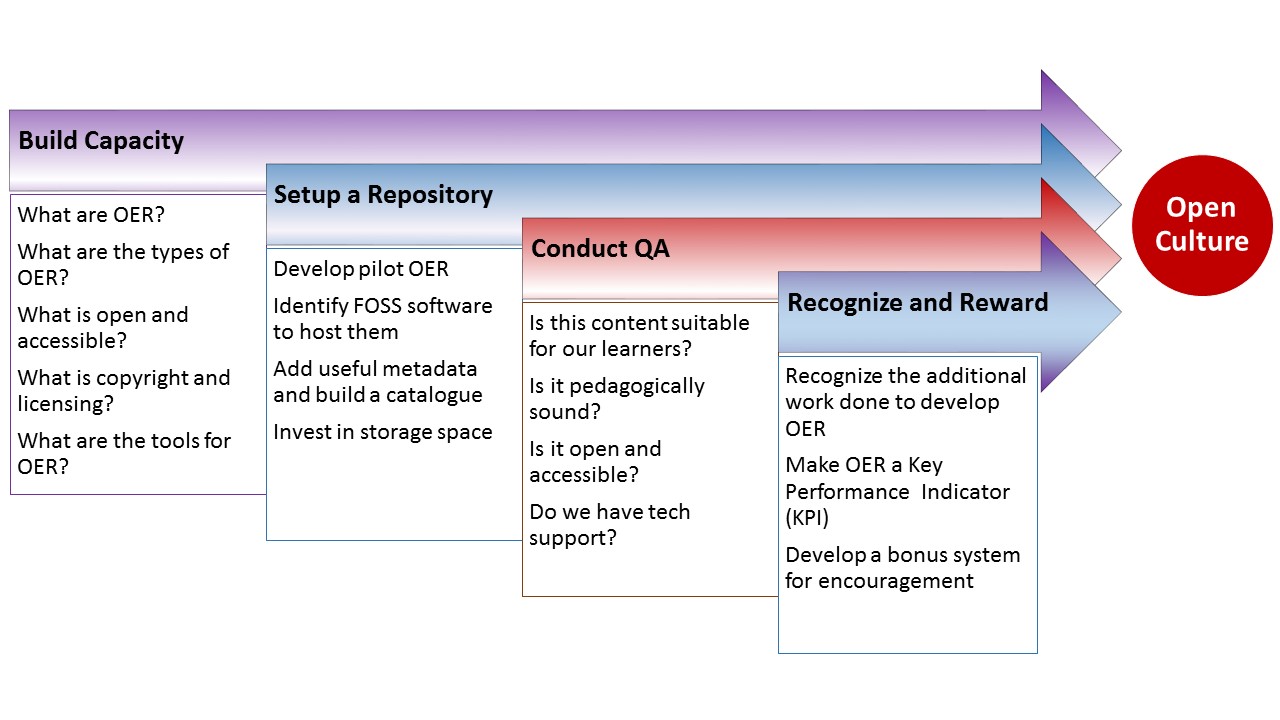
My previous blog post on “Five Tips for Using OER like a Pro” ended on the note
“If you feel that OER is a philosophy you believe in, just go ahead and practice it. Let organizations like COL work with your institution and government to put in place the necessary guidelines”.
Having said that, I thought I needed to follow-up with a post explaining how an institution should go about implementing an OER policy once COL has assisted in developing it. The following four tips will get you started:
1. Build capacity
You might have the perfect institutional OER policy. This means nothing if the people on the ground have no clue about OER. So, it all boils down to “cluing-in” your teachers. i.e. capacity building is the name of the game.
Start by defining what OER are using the 2012 Paris OER Declaration. Tell them that there are many forms of OER available such as course materials which can be found using COL’s Directory of Open Educational Resources (DOER) or OER Commons, images such as the ones found in Wikimedia Commons or Flick: Creative Commons and video from NPTEL. Explain that the “O” stands for the 4Rs of OER with a 5th R being added recently. Guide them through the ALMS analysis to give them an understanding of how accessible an OER should be and point them to the Creative Commons to make sense of all the copyright mumbo-jumbo. Finally, give some training in free and open source software (FOSS) tools such as Open Office, Google Docs, Gimp, Audacity, VirtualDub and PSPP to empower them.
2. Setup a repository
Now that your teachers are developing new OER, you need to find a central place to put them. The library website is the popular choice. However, since your OER should be accessible freely by anyone with an internet connection (else why go OER in the first place?) whereas the library should only be accessible to your students, it pays to have a look at a few FOSS repositories such as DSpace to host your OER. This will also help you to manage web traffic better when thousands of visitors come looking for OER from your institution. Adopt a metadata standard for marketing your OER to search engines. Two of the popular ones are IEEE-Learning Object Metadata (IEEE-LOM) and Dublin Core Metadata Initiative (DCMI). The Learning Resource Metadata Initiative (LRMI), initiated by the Creative Commons, is now part of DCMI. Once you have figured out which repository platform and metadata standard you will be using (if in doubt, ask the librarian), you would want to decide whether to host it internally or on the cloud. As your collection of OER grows, you will need more and more storage space. This need will be exponential if you create a lot of multimedia material such as video. A word to the wise, go for cloud based hosting from the start. It’s comparatively cheap, reliable, scalable and relatively safe.
3. Conduct QA
Take your quality assurance (QA) seriously when it comes to OER. You are putting the reputation of the institution on the line. Check whether your OER are relevant to your students with respect to content and pedagogy. Look at the licenses and file types to see if your OER are desirable. Use COL’s TIPS framework to guide your OER QA process. Also, make sure you form an OER taskforce which can help teachers and students with issues or doubts. Let the information available from COL for the general public, teachers and students be your guiding light.
4. Recognize and Reward
Many of us are needy when it comes to rewards and recognition. Being a teacher myself, I believe that teachers are worse. Having said that, most of the time we are not looking for monetary rewards but rather recognition of our intellectual labors of love. Let’s face it; locating, reusing, revising and remixing OER is no walk in the park. It requires a lot of effort, persistence and perseverance. As an institution, look at how contributions to OER can be openly recognized. This will act as a motivating factor. Including contributions to OER as a Key Performance Indicator (KPI) can also be a viable way of recognizing the toil a teacher has to go through to make that textbook open. Also, a small bonus wouldn’t hurt.
OER are just one part of an already prominent open movement. Ultimately, all these movements should converge into an Open Culture where shared knowledge forms the basis of a much wiser human race.
References
Abeywardena, I.S. (2012). A report on the Re-use and Adaptation of Open Educational Resources (OER): An Exploration of Technologies Available. Commonwealth of Learning. Available at http://oasis.col.org/handle/11599/233.


